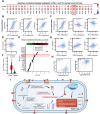Resetting the Hsc70-mediated lysosomal degradation of PD-L1 via a supramolecular meso peptide for the restoration of acquired anti-tumor T cell immunity
- PMID: 39905428
- PMCID: PMC11792358
- DOI: 10.1186/s12951-025-03171-x
Resetting the Hsc70-mediated lysosomal degradation of PD-L1 via a supramolecular meso peptide for the restoration of acquired anti-tumor T cell immunity
Abstract
The reduction of cellular PD-L1 abundance through lysosomal degradation is recognized as essential for effective and sustained targeting of PD-L1-dependent immune evasion in cancer. While Hsc70 can interact with PD-L1 to promote its lysosomal degradation, the overexpression of CMTM6 competitively inhibits this interaction, leading to the blockade of PD-L1 lysosomal degradation. To overcome this issue, a meso chimeric peptide PEPPDL1 was designed to specifically bind the PD-1 binding domain of PD-L1 instead of the Hsc70/CMTM6 binding domain, while also binding to Hsc70 to facilitate the dragging of PD-L1 into Hsc70-mediated chaperone-mediated autophagy (CMA), thereby achieving lysosomal degradation. In order to enable internalization into tumor cells, supramolecular engineering techniques were employed through terminal modification involving sulfydryl and monovalent gold ion (Au(I)), both facilitating self-assembly of modified PEPPDL1 into supramolecular nanospheres termed CTAC-PDL1 driven by aurophilic interaction. Furthermore, based on bioinformatics analysis of mRNA expression data from 30 types of tumors obtained from TCGA database, malignant melanoma was identified as the most suitable indication for CTAC-PDL1 due to its specific characteristics of tumor immune. As expected, CTAC-PDL1 effectively reactivated Hsc70-mediated lysosomal degradation of PD-L1 and consequently restored anti-tumor T cell immunity in a B16F10-derived mouse model of malignant melanoma while maintaining a favorable safety profile. Overall, this work not only presents an alternative approach for targeting PD-L1-dependent cancer immune evasion, but also provides a modularized strategy for discovering specific regulators for target proteins in various diseases.
Keywords: Cellular abundance of PD-L1; Lysosomal degradation; Peptide; Supramolecule; Tumor immunotherapy.
© 2025. The Author(s).
Conflict of interest statement
Declarations. Ethics approval and consent to participate: All experimental procedures involving animals were conducted in accordance with Institution Guidelines and were approved by the Medical Ethics Committee of Xi’an Jiaotong University. Consent for publication: All authors of this study agreed to publish. Competing interests: The authors declare no competing interests.
Figures






Similar articles
-
Hsc70 promotes anti-tumor immunity by targeting PD-L1 for lysosomal degradation.Nat Commun. 2024 May 18;15(1):4237. doi: 10.1038/s41467-024-48597-3. Nat Commun. 2024. PMID: 38762492 Free PMC article.
-
Reinvigoration of cytotoxic T lymphocytes in microsatellite instability-high colon adenocarcinoma through lysosomal degradation of PD-L1.Nat Commun. 2024 Aug 13;15(1):6922. doi: 10.1038/s41467-024-51386-7. Nat Commun. 2024. PMID: 39134545 Free PMC article.
-
Hepatitis C Virus NS5A Protein Promotes the Lysosomal Degradation of Hepatocyte Nuclear Factor 1α via Chaperone-Mediated Autophagy.J Virol. 2018 Jun 13;92(13):e00639-18. doi: 10.1128/JVI.00639-18. Print 2018 Jul 1. J Virol. 2018. PMID: 29695419 Free PMC article.
-
N6-methyladenosine-modified circIGF2BP3 inhibits CD8+ T-cell responses to facilitate tumor immune evasion by promoting the deubiquitination of PD-L1 in non-small cell lung cancer.Mol Cancer. 2021 Aug 20;20(1):105. doi: 10.1186/s12943-021-01398-4. Mol Cancer. 2021. PMID: 34416901 Free PMC article.
-
O-GlcNAcylation promotes tumor immune evasion by inhibiting PD-L1 lysosomal degradation.Proc Natl Acad Sci U S A. 2023 Mar 28;120(13):e2216796120. doi: 10.1073/pnas.2216796120. Epub 2023 Mar 21. Proc Natl Acad Sci U S A. 2023. PMID: 36943877 Free PMC article.
References
-
- Kim TK, Vandsemb EN, Herbst RS, Chen L. Adaptive immune resistance at the tumour site: mechanisms and therapeutic opportunities. Nat Rev Drug Discovery. 2022;21:529–40. - PubMed
-
- Zhou X, Yao Z, Bai H, Duan J, Wang Z, Wang X, Zhang X, Xu J, Fei K, Zhang Z, et al. Treatment-related adverse events of PD-1 and PD-L1 inhibitor-based combination therapies in clinical trials: a systematic review and meta-analysis. Lancet Oncol. 2021;22:1265–74. - PubMed
-
- Pang K, Shi Z-D, Wei L-Y, Dong Y, Ma Y-Y, Wang W, Wang G-Y, Cao M-Y, Dong J-J, Chen Y-A, et al. Research progress of therapeutic effects and drug resistance of immunotherapy based on PD-1/PD-L1 blockade. Drug Resist Updates. 2023;66:100907. - PubMed
MeSH terms
Substances
Grants and funding
LinkOut - more resources
Full Text Sources
Research Materials
Miscellaneous

